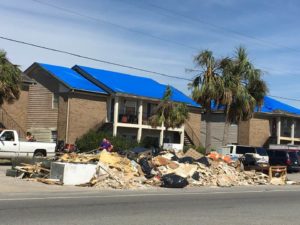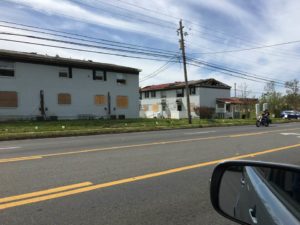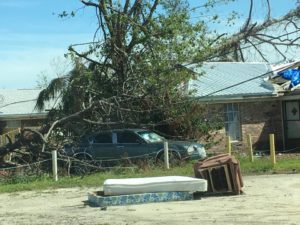Legislature amassing $Billion+ Recovery Packages

Blue roof tarps remain a common sight in Florida’s Panhandle, March 10, 2019
Insured losses from Hurricane Michael are growing at a faster rate, with a nearly $200 million increase in the first half of March, double each of the previous 15-day reporting periods since the beginning of the year. While most of the relatively simpler mobile home and dwelling claims have been settled, commercial property claims clearance rates are lagging, along with other more expensive lines – an indication that Michael’s total losses may well exceed the originally estimated $10 billion.
The Florida Office of Insurance Regulation (OIR) reports that as of March 15, total estimated insured losses are nearly $6.1 billion. That’s a $200 million increase from its previous report on February 28. Previous 15-day updates have increased about $100 million from each prior report since January. To date, there have been 144,116 claims.
While nearly 80% of overall claims have been closed, a look at different lines reveals that the more expensive ones are lagging behind. OIR figures show mobile homes (88%), private flood (83%), and dwelling (82%) are ahead of the curve in settlement, with homeowners (77%) just under and commercial residential (58%) way under the curve. But commercial property lines claims from Michael have been even slower to settle, with only 44% of those claims settled as of March 15. Business interruption insurance has a current closure rate of 42.5%.

Many commercial residential units in and around Panama City were damaged in Hurricane Michael, March 20, 2019
This is not altogether surprising. Commercial residential and commercial property lines are traditionally some of the most complex and expensive claims to settle from a catastrophe. In the coming months though, we’ll be watching for any signs of what analysts call “loss creep”: increased expenses from processing and settling claims – including ever-growing litigation costs, prompted in part by Assignment of Benefits (AOB) contracts between vendors and policyholders. Such loss creep is blamed, in part, for insurance costs in 2017’s Hurricane Irma being 26% higher than originally estimated, at $11.1 billion.
Many victims of Michael had no insurance or were underinsured. Local governments, too, are overwhelmed in their relief and recovery efforts as we’ve been reporting. This past week the Florida House and Senate each released spending proposals to fund recovery efforts in the Panhandle. The Senate plan funds $1.8 billion and the House plan is currently $1.5 billion.

Damage and debris remain in Panama City from Hurricane Michael, March 10, 2019
Senate President Bill Galvano (R-Bradenton) noted “the Senate is dedicating funding to restore critical life-safety services to panhandle communities, build and provide affordable housing options for displaced families, rebuild local government infrastructure, repair critical county and municipal roads and rebuild education facilities. Our K-12 Education budget includes additional funding to cover losses due to declined enrollment in impacted counties, and we also include funding to restore tourism and recreational opportunities and provide technical support for local governments to secure reimbursements.”
Both the Senate and House versions may change in the coming weeks during budget negotiations between chambers, leading to a final budget by the end of session in early May. (see this edition’s Bill Watch for further details).
FEMA reports that debris pickup and code enforcement on untouched hurricane-damaged properties are the most significant issues in the 12-county impacted region. Starting April 10, six months after the hurricane, Panama City will enforce code violations at properties that show no clean-up or rehab started. It is urging people to contact the city about the FEMA-funded private property debris program.
LMA Newsletter of 3-25-19

